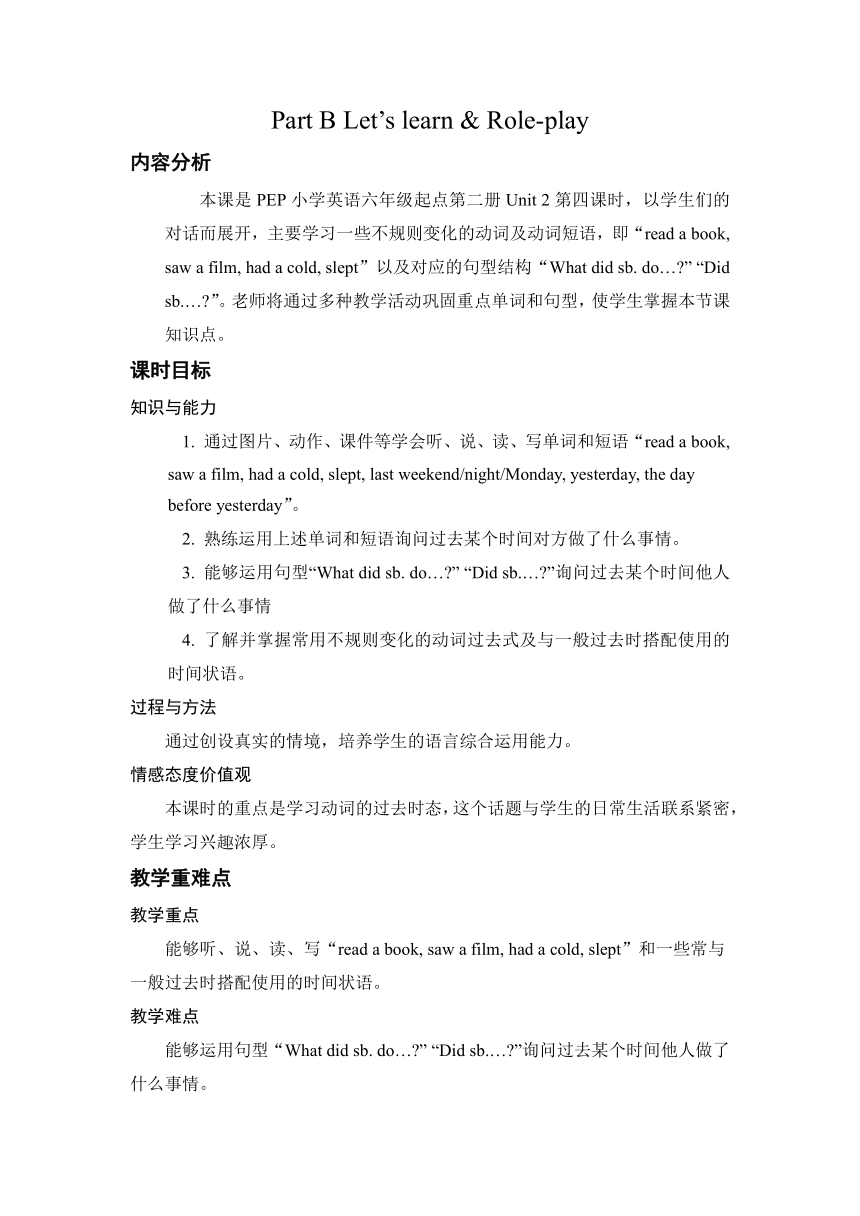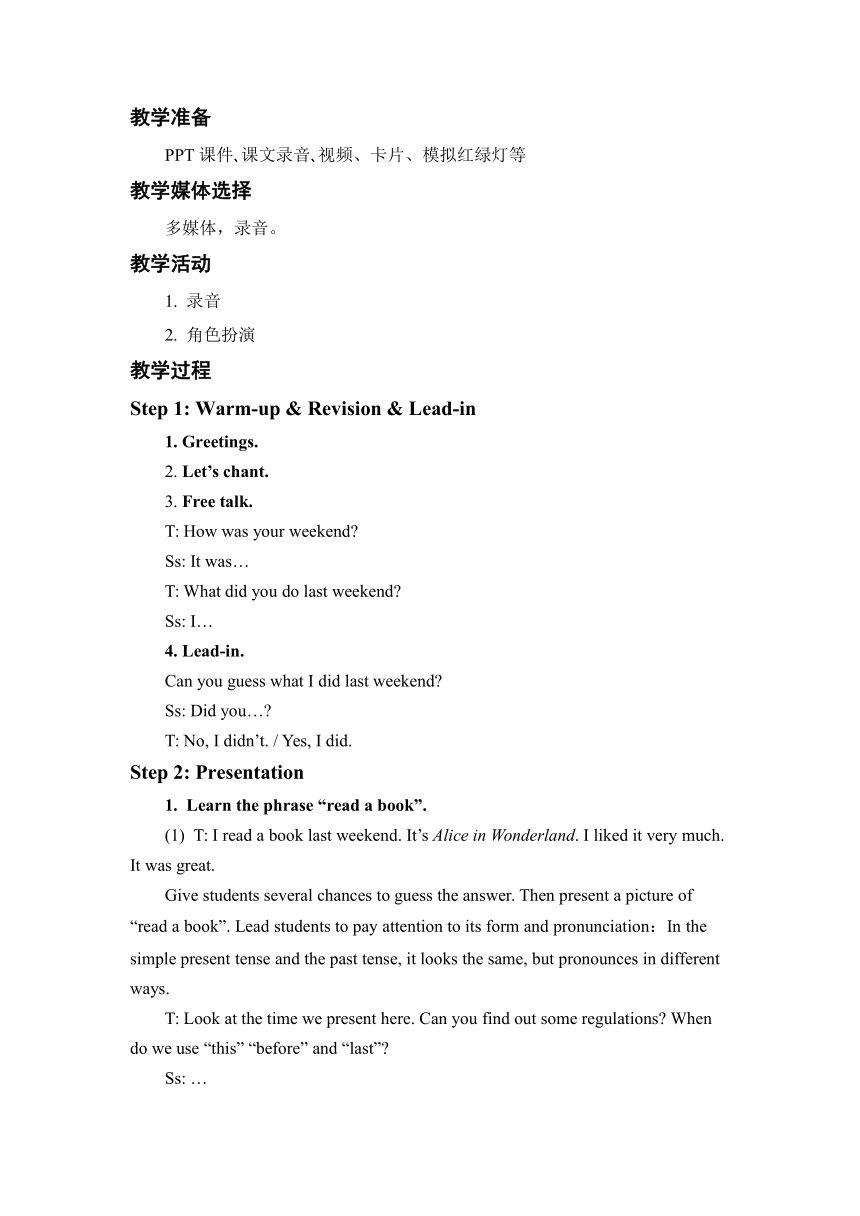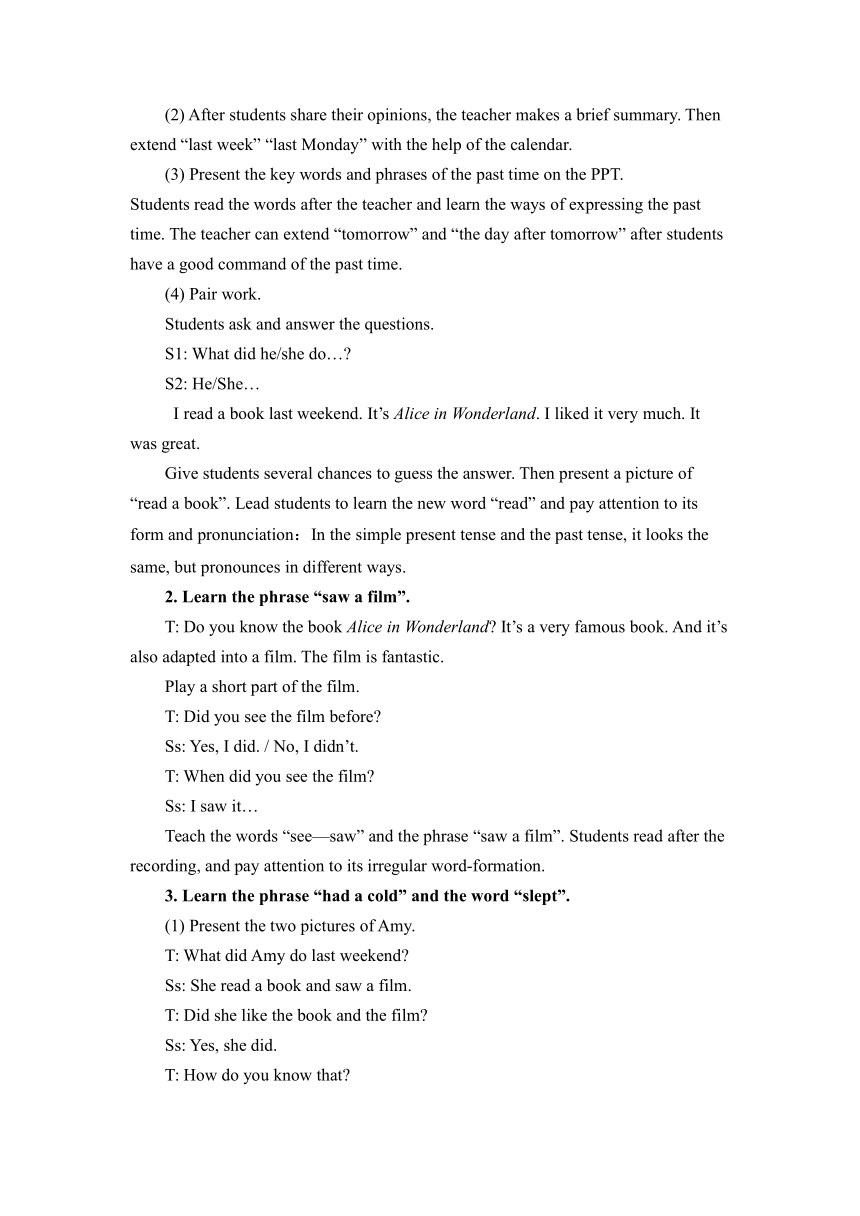Unit 2 Last weekend Part B Let’s learn 教案
文档属性
| 名称 | Unit 2 Last weekend Part B Let’s learn 教案 |  | |
| 格式 | docx | ||
| 文件大小 | 22.1KB | ||
| 资源类型 | 教案 | ||
| 版本资源 | 人教版(PEP) | ||
| 科目 | 英语 | ||
| 更新时间 | 2022-02-27 20:29:28 | ||
图片预览



文档简介
Part B Let’s learn & Role-play
内容分析
本课是PEP小学英语六年级起点第二册Unit 2第四课时,以学生们的对话而展开,主要学习一些不规则变化的动词及动词短语,即“read a book, saw a film, had a cold, slept”以及对应的句型结构“What did sb. do… ” “Did sb.… ”。老师将通过多种教学活动巩固重点单词和句型,使学生掌握本节课知识点。
课时目标
知识与能力
通过图片、动作、课件等学会听、说、读、写单词和短语“read a book, saw a film, had a cold, slept, last weekend/night/Monday, yesterday, the day before yesterday”。
熟练运用上述单词和短语询问过去某个时间对方做了什么事情。
能够运用句型“What did sb. do… ” “Did sb.… ”询问过去某个时间他人做了什么事情
了解并掌握常用不规则变化的动词过去式及与一般过去时搭配使用的时间状语。
过程与方法
通过创设真实的情境,培养学生的语言综合运用能力。
情感态度价值观
本课时的重点是学习动词的过去时态,这个话题与学生的日常生活联系紧密,学生学习兴趣浓厚。
教学重难点
教学重点
能够听、说、读、写“read a book, saw a film, had a cold, slept”和一些常与一般过去时搭配使用的时间状语。
教学难点
能够运用句型“What did sb. do… ” “Did sb.… ”询问过去某个时间他人做了什么事情。
教学准备
PPT课件 课文录音 视频、卡片、模拟红绿灯等
教学媒体选择
多媒体,录音。
教学活动
录音
角色扮演
教学过程
Step 1: Warm-up & Revision & Lead-in
1. Greetings.
2. Let’s chant.
3. Free talk.
T: How was your weekend
Ss: It was…
T: What did you do last weekend
Ss: I…
4. Lead-in.
Can you guess what I did last weekend
Ss: Did you…
T: No, I didn’t. / Yes, I did.
Step 2: Presentation
Learn the phrase “read a book”.
T: I read a book last weekend. It’s Alice in Wonderland. I liked it very much. It was great.
Give students several chances to guess the answer. Then present a picture of “read a book”. Lead students to pay attention to its form and pronunciation:In the simple present tense and the past tense, it looks the same, but pronounces in different ways.
T: Look at the time we present here. Can you find out some regulations When do we use “this” “before” and “last”
Ss: …
(2) After students share their opinions, the teacher makes a brief summary. Then extend “last week” “last Monday” with the help of the calendar.
(3) Present the key words and phrases of the past time on the PPT.
Students read the words after the teacher and learn the ways of expressing the past time. The teacher can extend “tomorrow” and “the day after tomorrow” after students have a good command of the past time.
(4) Pair work.
Students ask and answer the questions.
S1: What did he/she do…
S2: He/She…
I read a book last weekend. It’s Alice in Wonderland. I liked it very much. It was great.
Give students several chances to guess the answer. Then present a picture of “read a book”. Lead students to learn the new word “read” and pay attention to its form and pronunciation:In the simple present tense and the past tense, it looks the same, but pronounces in different ways.
2. Learn the phrase “saw a film”.
T: Do you know the book Alice in Wonderland It’s a very famous book. And it’s also adapted into a film. The film is fantastic.
Play a short part of the film.
T: Did you see the film before
Ss: Yes, I did. / No, I didn’t.
T: When did you see the film
Ss: I saw it…
Teach the words “see—saw” and the phrase “saw a film”. Students read after the recording, and pay attention to its irregular word-formation.
3. Learn the phrase “had a cold” and the word “slept”.
(1) Present the two pictures of Amy.
T: What did Amy do last weekend
Ss: She read a book and saw a film.
T: Did she like the book and the film
Ss: Yes, she did.
T: How do you know that
Ss: Because when she read the book and saw the film, she looked happy.
(2) Present the two pictures of John.
T: How did John feel
Ss: He felt sad/bad/sick/tired…
T: Why did John feel so bad
Ss: Because he had a cold.
T: No wonder he slept. Maybe sleeping could help him feel better.
Teach the new words and the phrase. Lead students to read after the recording, and pay attention to their irregular word-formation.
Step 3: Practice
1. Game
T: Can you read the words and the phrases presented on the steps correctly
Ss: Yes, we can!
Then students read these words on the steps.
2. Read in roles.
(1) Play the video of “Let’s learn”. Students read after the video and pay attention to the pronunciation and the intonation.
Make sure students can read the dialogue correctly, fluently and emotionally.
(2) Students read the dialogue in roles. Boys play the role of John, and girls play the role of Amy.
3. Guess and say.
Can you guess what Amy and John did yesterday
(1) The teacher makes a model with a student. Show students how to conduct the conversation.
(2) Highlight the sentence structure. Teach students how to use it.
(3) Students look at the pictures. A student asks the question, and the others answer it.
Step 4: Consolidation & Extension
Pair work.
Work in pairs. Ask and answer the questions about what you did in the past time.
2. Let’s play a game.
Present the words.
We’ll play like this:
S1: Last Sunday, I… (A)
S2: Last Sunday, I… (A & B)
S3: Last Sunday, I… (A & B & C)
S4: …
T: Let’s see who has the best memory.
Choose the winner.
3. Look and talk.
(1) Divide students into several groups. Let students work in groups and look at the table below for a few seconds, then cover it. Ask and answer.
(2) Show time.
Students show their dialogues. They can conduct the dialogue like this:
A: What did John do yesterday
B: He slept.
A: Did he have a cold yesterday
B: Yes, he did.
板书设计 Unit 2 Last weekend
read—read a book see—saw a film
have—had a cold sleep—slept
What did you do last weekend I ...
Did you like it? Yes,I did./No, I didn’t.
作业设计
口语交际:
用本课的句型提问和描述同学和自己的上周末活动
教学反思
在本堂课中,以新课标为理论指导,以学生为主体、训练为主线,利用卡片游戏,使学生在学中用、用中学。学用结合,激发学生的多元智能学习能力。
这节课以词汇教学为主,采用卡片、角色表演等多种形式来逐步引导学生操练单词、词组和句型,有效地帮助学生巩固重点词汇和句型。
呈现活动设计丰富,易操作,且具备层次感,有效地提升了学生的核心素养。以学生为本,以解决问题为导向,引导学生自主学习。
4.突出语用功能,联系学生和班级的实际情况,设置多个环节,环环相扣,层层深入,帮助学生在真实情景中自然地使用所学语言。
5.本课时的重点是学习一些表示过去的时间和动词短语,教师通过多种活动帮助学生将这个话题与他们的日常生活紧密联系起来,充分激发了学生的学习兴趣。
内容分析
本课是PEP小学英语六年级起点第二册Unit 2第四课时,以学生们的对话而展开,主要学习一些不规则变化的动词及动词短语,即“read a book, saw a film, had a cold, slept”以及对应的句型结构“What did sb. do… ” “Did sb.… ”。老师将通过多种教学活动巩固重点单词和句型,使学生掌握本节课知识点。
课时目标
知识与能力
通过图片、动作、课件等学会听、说、读、写单词和短语“read a book, saw a film, had a cold, slept, last weekend/night/Monday, yesterday, the day before yesterday”。
熟练运用上述单词和短语询问过去某个时间对方做了什么事情。
能够运用句型“What did sb. do… ” “Did sb.… ”询问过去某个时间他人做了什么事情
了解并掌握常用不规则变化的动词过去式及与一般过去时搭配使用的时间状语。
过程与方法
通过创设真实的情境,培养学生的语言综合运用能力。
情感态度价值观
本课时的重点是学习动词的过去时态,这个话题与学生的日常生活联系紧密,学生学习兴趣浓厚。
教学重难点
教学重点
能够听、说、读、写“read a book, saw a film, had a cold, slept”和一些常与一般过去时搭配使用的时间状语。
教学难点
能够运用句型“What did sb. do… ” “Did sb.… ”询问过去某个时间他人做了什么事情。
教学准备
PPT课件 课文录音 视频、卡片、模拟红绿灯等
教学媒体选择
多媒体,录音。
教学活动
录音
角色扮演
教学过程
Step 1: Warm-up & Revision & Lead-in
1. Greetings.
2. Let’s chant.
3. Free talk.
T: How was your weekend
Ss: It was…
T: What did you do last weekend
Ss: I…
4. Lead-in.
Can you guess what I did last weekend
Ss: Did you…
T: No, I didn’t. / Yes, I did.
Step 2: Presentation
Learn the phrase “read a book”.
T: I read a book last weekend. It’s Alice in Wonderland. I liked it very much. It was great.
Give students several chances to guess the answer. Then present a picture of “read a book”. Lead students to pay attention to its form and pronunciation:In the simple present tense and the past tense, it looks the same, but pronounces in different ways.
T: Look at the time we present here. Can you find out some regulations When do we use “this” “before” and “last”
Ss: …
(2) After students share their opinions, the teacher makes a brief summary. Then extend “last week” “last Monday” with the help of the calendar.
(3) Present the key words and phrases of the past time on the PPT.
Students read the words after the teacher and learn the ways of expressing the past time. The teacher can extend “tomorrow” and “the day after tomorrow” after students have a good command of the past time.
(4) Pair work.
Students ask and answer the questions.
S1: What did he/she do…
S2: He/She…
I read a book last weekend. It’s Alice in Wonderland. I liked it very much. It was great.
Give students several chances to guess the answer. Then present a picture of “read a book”. Lead students to learn the new word “read” and pay attention to its form and pronunciation:In the simple present tense and the past tense, it looks the same, but pronounces in different ways.
2. Learn the phrase “saw a film”.
T: Do you know the book Alice in Wonderland It’s a very famous book. And it’s also adapted into a film. The film is fantastic.
Play a short part of the film.
T: Did you see the film before
Ss: Yes, I did. / No, I didn’t.
T: When did you see the film
Ss: I saw it…
Teach the words “see—saw” and the phrase “saw a film”. Students read after the recording, and pay attention to its irregular word-formation.
3. Learn the phrase “had a cold” and the word “slept”.
(1) Present the two pictures of Amy.
T: What did Amy do last weekend
Ss: She read a book and saw a film.
T: Did she like the book and the film
Ss: Yes, she did.
T: How do you know that
Ss: Because when she read the book and saw the film, she looked happy.
(2) Present the two pictures of John.
T: How did John feel
Ss: He felt sad/bad/sick/tired…
T: Why did John feel so bad
Ss: Because he had a cold.
T: No wonder he slept. Maybe sleeping could help him feel better.
Teach the new words and the phrase. Lead students to read after the recording, and pay attention to their irregular word-formation.
Step 3: Practice
1. Game
T: Can you read the words and the phrases presented on the steps correctly
Ss: Yes, we can!
Then students read these words on the steps.
2. Read in roles.
(1) Play the video of “Let’s learn”. Students read after the video and pay attention to the pronunciation and the intonation.
Make sure students can read the dialogue correctly, fluently and emotionally.
(2) Students read the dialogue in roles. Boys play the role of John, and girls play the role of Amy.
3. Guess and say.
Can you guess what Amy and John did yesterday
(1) The teacher makes a model with a student. Show students how to conduct the conversation.
(2) Highlight the sentence structure. Teach students how to use it.
(3) Students look at the pictures. A student asks the question, and the others answer it.
Step 4: Consolidation & Extension
Pair work.
Work in pairs. Ask and answer the questions about what you did in the past time.
2. Let’s play a game.
Present the words.
We’ll play like this:
S1: Last Sunday, I… (A)
S2: Last Sunday, I… (A & B)
S3: Last Sunday, I… (A & B & C)
S4: …
T: Let’s see who has the best memory.
Choose the winner.
3. Look and talk.
(1) Divide students into several groups. Let students work in groups and look at the table below for a few seconds, then cover it. Ask and answer.
(2) Show time.
Students show their dialogues. They can conduct the dialogue like this:
A: What did John do yesterday
B: He slept.
A: Did he have a cold yesterday
B: Yes, he did.
板书设计 Unit 2 Last weekend
read—read a book see—saw a film
have—had a cold sleep—slept
What did you do last weekend I ...
Did you like it? Yes,I did./No, I didn’t.
作业设计
口语交际:
用本课的句型提问和描述同学和自己的上周末活动
教学反思
在本堂课中,以新课标为理论指导,以学生为主体、训练为主线,利用卡片游戏,使学生在学中用、用中学。学用结合,激发学生的多元智能学习能力。
这节课以词汇教学为主,采用卡片、角色表演等多种形式来逐步引导学生操练单词、词组和句型,有效地帮助学生巩固重点词汇和句型。
呈现活动设计丰富,易操作,且具备层次感,有效地提升了学生的核心素养。以学生为本,以解决问题为导向,引导学生自主学习。
4.突出语用功能,联系学生和班级的实际情况,设置多个环节,环环相扣,层层深入,帮助学生在真实情景中自然地使用所学语言。
5.本课时的重点是学习一些表示过去的时间和动词短语,教师通过多种活动帮助学生将这个话题与他们的日常生活紧密联系起来,充分激发了学生的学习兴趣。
